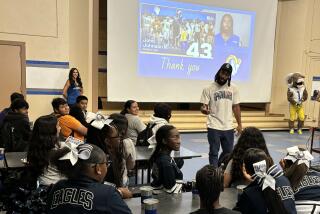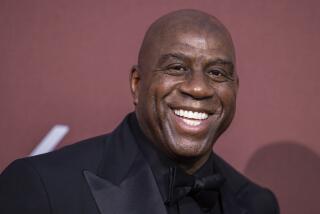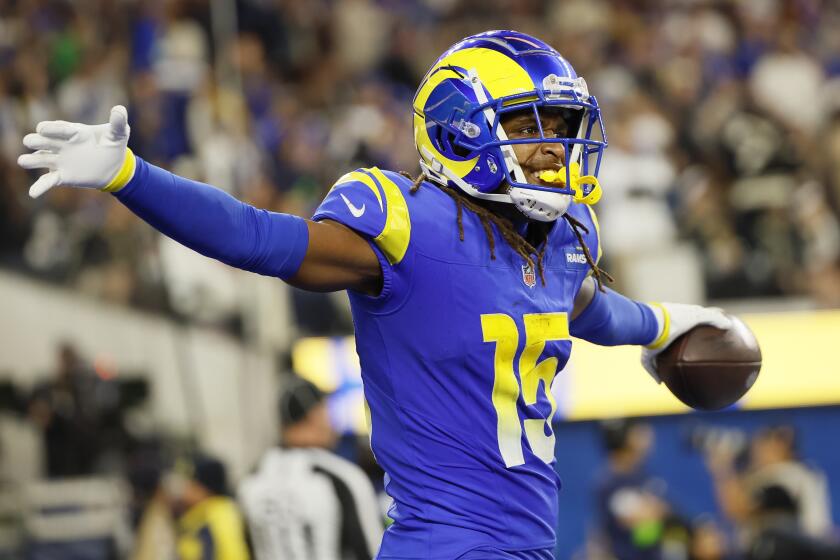Magic Has Statue of No Limitations
The problem with an appreciation is that is can read like an obituary. It helps when the subject is alive, as Magic Johnson indeed is, and there are a lot of other people doing the appreciating, as there were Wednesday evening outside Staples Center.
The occasion was the unveiling of a statue of Johnson, not quite a full-court pass from the one of the Great Gretzky. For any athlete aspiring to his own statue in Los Angeles, a snappy nickname apparently furthers the cause. There might be one of Sandy Koufax outside Dodger Stadium if only he had been known as “Big Train” or “Catfish.”
Looking on was a crowd of several hundred, including speakers such as Mayor James K. Hahn, NBA Commissioner David Stern, Jerry West, Kareem Abdul-Jabbar and James Worthy, while Johnson ripped the purple cloth cover from the 17-foot bronze statue.
As for whether the Israeli sculptor, Omri Amrany, has created a work of art, that is for a critic in another section of the newspaper to determine. But Johnson seemed to like it.
He mentioned in particular the smile.
It wasn’t the “winning time” smile, the one that emcee Brent Musburger declared “turned around the NBA.”
That was the smile that Stern mentioned first this week when asked to explain Johnson’s enduring popularity, as evidenced by the number of times he’s being honored this week as the NBA’s best and brightest (and some of the not so bright) arrive for the All-Star game Sunday at Staples Center. Stern said Johnson took him back to a much simpler time, when it was possible to believe that a player could love the game so much “that he would play for nothing. It was written on his face.”
This smile, the one the sculptor deftly captured in his depiction of Johnson throwing a no-look pass, was the gotcha smile Johnson would ever so briefly flash when he realized there was a teammate at the end of an open passing lane.
“How can I help you?” Johnson said he recalls thinking to himself at those moments. “James, here’s the ball. Kareem, here I come.”
*
When Johnson revealed in November 1991 that he was HIV-positive, it might have been possible to predict that there someday would be a statue of him in Los Angeles. Less predictable was that he would be here to see it.
Little was known then about the virus and its treatment. The assumption was that it would evolve into AIDS, which meant death -- maybe within five years, almost certainly within 10.
Stern, whose success in reviving the league in the ‘80s was attributable in no small part to Johnson and Larry Bird, said this week that he wouldn’t have believed it if he had been told 12 years ago that Johnson would be healthy today. Stern’s response, he said, would have been, “Statistically, that isn’t going to happen.”
As the Laker coach for most of the ‘80s, Pat Riley witnessed Johnson’s maturation as the team leader, inspiring with his play and almost unflagging positive attitude. But Riley said that even he didn’t believe Johnson was a match for HIV.
“I was like everyone else,” Riley said. “He had something that was life-threatening, career-ending, reputation-damaging and, emotionally, I didn’t see him bouncing back from it.
“But that is part of what makes him an amazing, amazing person. He got up, jumped into the fight and began helping other people. He realized he wanted to save himself and that he really wanted to save others. That’s the way he was as a player.
“Magic didn’t believe he could win championships by himself, but he did believe he could win them if he helped make everyone around him better. He did that with me, with my coaching. He took everybody to another level.”
He lifted the Lakers to five NBA championships. They reached the Finals nine times in 12 seasons. That, however, is merely the foundation for his legacy. It is also the least important part of it.
Most significant is his battle against HIV. His Magic Johnson Foundation has raised millions of dollars for AIDS research and prevention. Doctors say he is a valuable example that it is possible to not only survive but thrive with HIV. He looks so healthy today that it’s seldom mentioned that he’s still undergoing treatment for the virus.
He has been more visible in his role as entrepreneur. American Express, in full-page newspaper advertisements this week, has noted its relationship with “Earvin” and “Magic” the basketball player and “Mr. Johnson” the businessman.
Johnson said recently that he will be worth $750 million someday if the Starbucks coffeehouses, the TGI Friday’s restaurants, the movie theaters, a record label and movie production company he oversees nationwide continue to prosper. He can put all of that money into the bank he also owns.
“For years, black athletes have been criticized for their one-dimensionality,” said Todd Boyd, a USC cinema professor who wrote “Young, Black, Rich & Famous, the Rise of the NBA, the Hip Hop Invasion and the Transformation of American Culture.”
“They have been criticized for being just athletes. The image of them is of making poor choices with their money. But Magic, and also Michael Jordan, have proven to be successful entrepreneurs, very shrewd.”
That Johnson placed most of his businesses “not in Santa Monica, Brentwood and Bel-Air but in urban and inner-city areas where they didn’t exist before,” Boyd said, has made him more appreciated in the African American community. He has given the previously disenfranchised the opportunity to overpay for coffee, for which he is applauded.
“He is equally popular here in the streets and in the boardrooms of corporate America,” Boyd said.
Asked whether he believed Johnson could succeed in a third arena, politics, Boyd said, “If Arnold can be governor, why couldn’t Magic be mayor?”
*
Johnson is a quintessential Laker, on a pedestal with West and no one else. Wilt Chamberlain was with the team for too short a time. Elgin Baylor, whose timing was usually impeccable, retired too soon, before the winning streak and the ’72 championship. Abdul-Jabbar had difficulty connecting with the public and his teammates.
Shaquille O’Neal has the personality but perhaps not the drive. Kobe Bryant, his legal situation and his upcoming free agency notwithstanding, has the drive but probably not the personality.
Ask fans what else they remember about Johnson’s basketball career and some will say the clutch shots (the baby sky hook against Boston in ‘87), others will say his steering of the fastbreak, and still others will say his remarkable passes.
“I can’t tell you how exciting it was to be on the end of some of those passes,” Worthy said.
West, who said that he had never called Earvin Johnson by his nickname until Wednesday’s ceremony, said that he was “the most incredible player I’ve ever seen in my life.”
He added that he believed that more because of Johnson’s “substance than his flair.”
Riley described Johnson as a blue-collar player. His nickname for Johnson was “Buck.”
Life, though, wasn’t always perfect for Johnson on the court. He faced several crises, all of which seem trivial in comparison with his disease. But on the night in Salt Lake City early in the 1981-82 season, when he said he wanted to be traded because of a dispute with then-coach Paul Westhead, Johnson’s image was temporarily shattered.
As a rookie who left Michigan State after his sophomore year, Johnson had started the season by exuberantly leaping into Abdul-Jabbar’s arms after a victory and ended it by replacing an injured Abdul-Jabbar at center in the Lakers’ Game 6, championship-clinching victory against Philadelphia.
Early the next season, he injured his knee and missed 45 games. His transition back didn’t go smoothly, compounded when he took, and missed, the final shot of a loss to Houston that knocked the defending champion Lakers out of the playoffs in the first round.
The local newspapers wrote repeatedly in the off-season about the “star wars,” and it was against that backdrop that the 1981-82 season began. Eleven games into it, with a 7-4 record, owner Jerry Buss fired Westhead, who had coached them to the championship two seasons before.
Although Johnson didn’t demand Westhead’s ouster, the perception was that Magic had issued an ultimatum.
And although Laker management said it had contemplated the move even before Johnson’s trade request because it didn’t like the team’s slow-motion offense, Johnson was booed for a period of time, even at home.
Newspaper columnists wrote that Johnson had too much power for a player. The allusion to inmates running the asylum was used more than once. Johnson’s lucrative endorsement contract with 7-Up, for which he had made charming and popular commercials, wasn’t renewed.
Yet, Johnson’s stature within the team was restored, his leadership credentials established. Abdul-Jabbar would remain captain for the remainder of his career, but it became clear within weeks that the Lakers danced to Magic’s beat.
“We didn’t have a shot at winning consistently until he got with the team,” Abdul-Jabbar said Wednesday.
Former teammate Jamaal Wilkes recalled this week that several players grumbled privately about Westhead but knew that their future as Lakers, perhaps even their careers, would be jeopardized if they complained publicly.
“I don’t think even Kareem would have survived,” Wilkes said.
“Magic was the only one who could do it because of his relationship with Dr. Buss.”
But it was still a risk because of the tenor of the times. As the NBA’s rosters had become predominantly black, management had remained white.
It was highly unusual for a black player to challenge a white coach.
“We looked at it largely as a basketball issue, the players being unsatisfied with the coach, but you had to be aware of the racial connotation,” Wilkes said.
Riley, who was Westhead’s assistant and succeeded him as head coach, always defended Westhead for trying to develop a more reliable half-court offense than the one that had failed the Lakers in the playoffs against Houston. But Riley could have been talking about that episode when he said the attribute he admires most in Johnson is his courage.
“I never saw him run and hide from anything, whether it was a problem on the court or HIV or a business challenge,” Riley said.
Asked this week whether he and Johnson had patched up their differences, Westhead, now an assistant in Orlando, said they never had any he was aware of except for that one night.
“I wouldn’t say I had a Magic problem,” Westhead said.
“He was going through a tough time, and the team was going through a tough time, and everything came up [bad] for me. But Magic and I had always gotten along very well.”
They became reacquainted a few years later when Westhead coached at Loyola Marymount, where the Lakers practiced, and have remained in touch since.
Westhead said he would have come to the statue unveiling if Orlando hadn’t had a game Wednesday night.
“I certainly appreciate everything Magic has accomplished,” Westhead said. “He helped me get a ring. It’s the only one I ever got.”
More to Read
Go beyond the scoreboard
Get the latest on L.A.'s teams in the daily Sports Report newsletter.
You may occasionally receive promotional content from the Los Angeles Times.










